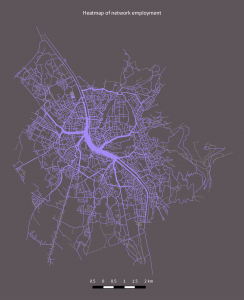Cities are known as complex, densely populated environments with transport infrastructure playing a substantial role. Accompanying a new wave of shifting people’s travel behavior to healthy mobility, improved cycling transportation may positively alter the comfort of travelers. A model of traffic flow can help city planners to delineate spots where road rearrangement is required. By means of a simulation approach the model can imitate disaggregated movements of a very large amount of travelers in a spatio-temporal manner. Characteristics of a built bicycle network and a natural environment influence the choice of every individual to use their preferred transport mode and route within a day. Thus, dynamic assignment of people’s daily activity schedules depends on a combination of their personal attributes, along with environmental conditions and interactions. These assumptions in transport modelling are supported by an agent-based approach, which allow unpredictable patterns to emerge.
The GI_Mobility Lab develops such bicycle traffic flow model for Salzburg city in the GAMA-platform simulation environment, using the agent-based modelling approach. A project partner, the Institute of Highway Engineering and Transport Planning from the Technical University of Graz, implements a classical 4-step transport modelling technique to develop similar bicycle demand model for Graz.



Leave A Comment